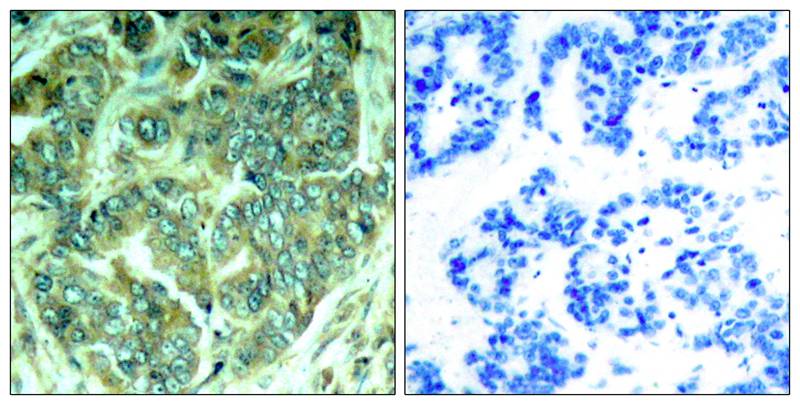

| WB | 咨询技术 | Human,Mouse,Rat |
| IF | 咨询技术 | Human,Mouse,Rat |
| IHC | 1/50-1/100 | Human,Mouse,Rat |
| ICC | 技术咨询 | Human,Mouse,Rat |
| FCM | 咨询技术 | Human,Mouse,Rat |
| Elisa | 咨询技术 | Human,Mouse,Rat |
| Aliases | DOK1 |
| Entrez GeneID | 1796; |
| WB Predicted band size | 62kDa |
| Host/Isotype | Rabbit IgG |
| Antibody Type | Primary antibody |
| Storage | Store at 4°C short term. Aliquot and store at -20°C long term. Avoid freeze/thaw cycles. |
| Species Reactivity | Human |
| Immunogen | Peptide sequence around phosphorylation site of tyrosine 398 (E-G-Y(p)-E-L) derived from Human p62Dok. |
| Formulation | Purified antibody in PBS with 0.05% sodium azide. |
+ +
以下是关于p62Dok(phospho-Tyr398)抗体的3篇参考文献摘要:
---
1. **文献名称**: "Role of Dok-1 and Dok-2 in Negative Regulation of T Cell Signaling"
**作者**: Niki T, et al.
**摘要**: 研究利用phospho-Tyr398特异性抗体,通过免疫印迹分析发现Dok-1在T细胞受体激活后发生酪氨酸磷酸化,抑制下游ERK和NF-κB信号通路,揭示其在T细胞活化中的负调控作用。
---
2. **文献名称**: "Dok1 Mediates Negative Regulation of Insulin Signaling Through its Phosphorylation at Tyrosine 398"
**作者**: Mashima R, et al.
**摘要**: 该文献通过Western blot和免疫沉淀技术,证实胰岛素刺激下Dok1在Tyr398位点的磷酸化促进其与RasGAP的结合,进而抑制PI3K/Akt通路,影响细胞代谢与增殖。
---
3. **文献名称**: "Tyrosine Phosphorylation of p62dok Induced by Cell Adhesion and Insulin"
**作者**: Yamanashi Y, Baltimore D.
**摘要**: 早期研究首次报道了p62Dok在细胞黏附和胰岛素刺激下的酪氨酸磷酸化现象,利用抗phospho-Tyr398抗体验证其参与整合素信号通路的调控,为后续功能研究奠定基础。
---
这些文献均通过特异性抗体检测p62Dok在Tyr398位点的磷酸化,并探讨其在细胞信号转导、免疫调控及疾病中的作用。如需具体实验细节,建议进一步查阅全文。
The p62Dok (phospho-Tyr398) antibody is a specialized tool used to detect the phosphorylated form of the docking protein p62Dok at tyrosine residue 398. p62Dok, a member of the Dok family of adapter proteins, plays a critical role in signal transduction pathways, particularly in immune regulation and oncogenesis. It acts downstream of receptor tyrosine kinases (RTKs) and cytokine receptors, modulating cellular processes like proliferation, differentiation, and apoptosis. Phosphorylation at Tyr398 is a key regulatory event triggered by activated receptors, enabling p62Dok to recruit SH2 domain-containing effectors such as RasGAP, which suppresses Ras/MAPK signaling. This post-translational modification is tightly linked to feedback mechanisms that fine-tune receptor signaling and maintain cellular homeostasis.
The p62Dok (phospho-Tyr398) antibody is widely utilized in research to investigate aberrant signaling in diseases like cancer, autoimmune disorders, and chronic inflammation. For example, hyperphosphorylation of p62Dok at Tyr398 has been implicated in BCR-ABL-driven leukemias, where dysregulated tyrosine kinase activity promotes uncontrolled cell growth. Structurally, p62Dok contains an N-terminal pleckstrin homology (PH) domain and a phosphotyrosine-binding (PTB) domain, which mediate membrane localization and receptor interactions, respectively. The C-terminal region harbors multiple tyrosine residues, including Tyr398. which serve as docking sites for downstream signaling molecules.
This antibody is essential for elucidating p62Dok’s role in pathological contexts and validating its potential as a therapeutic target or biomarker. Applications include Western blotting, immunohistochemistry, and flow cytometry to assess phosphorylation status in cell lines, tissues, or clinical samples.
×